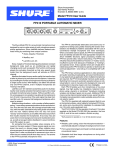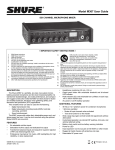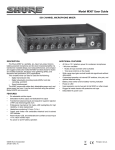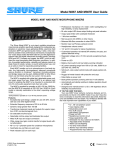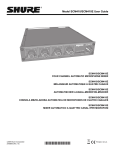Download Shure FP410 User guide
Transcript
Shure Brothers Incorporated 222 Hartrey Avenue Evanston IL 60202-3696 U.S.A. Model FP410 User Guide ÁÁÁÁ ÁÁÁÁÁÁÁÁÁÁÁÁÁÁÁÁÁÁÁÁÁÁÁ ÁÁÁÁÁÁÁÁÁÁÁ Á ÁÁÁ Á ÁÁÁ Á Á Á Á Á ÁÁÁÁÁÁÁÁ Á Á ÁÁ ÁÁ Á Á Á Á Á Á Á ÁÁ Á Á ÁÁ Á Á ÁÁ Á Á Á ÁÁ Á Á ÁÁ Á Á ÁÁÁ Á ÁÁÁÁÁÁÁÁÁÁÁÁÁÁÁÁÁÁÁÁÁÁÁ ÁÁÁÁÁÁÁÁÁÁÁÁÁÁÁÁÁÁÁÁÁÁÁ ÁÁ ÁÁ ÁÁ ÁÁ ÁÁÁÁÁÁÁÁÁÁÁ ÁÁ Á Á Á Á Á Á ÁÁÁÁÁÁÁÁÁÁÁÁÁÁÁÁÁÁÁÁÁÁÁÁÁ Á ÁÁÁ ÁÁÁÁÁÁÁ Á ÁÁÁÁ ÁÁÁÁÁ ÁÁÁÁ ÁÁÁÁ Á ÁÁÁÁÁÁÁÁÁÁÁÁÁÁÁÁÁÁÁÁÁÁÁÁÁ ÁÁ Á ÁÁ Á Á Á ÁÁ Á Á Á Á ÁÁÁ Á Á ÁÁÁÁÁÁÁÁÁÁÁÁÁÁÁÁÁÁÁÁÁÁÁÁÁ ÁÁÁ Á ÁÁ ÁÁÁ Á ÁÁ Á ÁÁ Á ÁÁ ÁÁ ÁÁ Á ÁÁ ÁÁÁ The Shure Model FP410E is an automatic microphone mixer designed for use in a wide variety of multi–microphone speech pickup applications. Shure IntelliMix is the remarkable new operational concept behind the FP410E. It delivers flawless automatic mixing by combining three unique functions: • Noise–Adaptive Threshold, • MaxBus, and • Last Mic Lock–On. Noise–Adaptive Threshold distinguishes between constant background noise (such as air conditioning) and rapidly changing sound (such as speech).This function continuously adjusts the activation threshold so that only speech levels louder than the background sound will activate an FP410E channel. MaxBus eliminates the poor audio quality that results when a talker is picked up by more than one microphone. It does this by controlling the number of microphones that may activate for a single sound source. With MaxBus, one talker will activate only one FP410E channel, even if multiple microphones are “hearing” that talker. Last Mic Lock–On maintains a seamless audio mix by keeping the most recently activated microphone open until a newly activated microphone takes its place. Without Last Mic Lock–On, a long pause in conversation may allow all microphones to turn off, and it may sound as if the audio signal has been lost. Last Mic Lock–On ensures that background ambience will always be present. Multiple miking situations—with a number of talkers participating—have always presented problems for the audio technician. If too few mics are used, the coverage of each talker may vary, with one talker (nearest the mic) being louder and clearer than the next. Talkers farthest from the mics will sound “echoey” and reverberant, as very little of the direct sound from their mouths reaches the microphones. If too many mics are used, there’s more background noise and reverberation pickup, as well as less gain before feedback if a sound reinforcement (PA) system is used. It’s somewhat like having multiple video cameras all focused on the same subject. If these camera signals are combined, the result is a blurred image. When multiple microphones are open for a single talker, the result is a blurred audio signal. But it’s often not practical for someone to turn mics on when they are needed and off when they are not. The answer is the FP410E automatic microphone mixer. The FP410E automatically attenuates (turns down) any microphone not being used, greatly reducing the excess reverberation and feedback problems associated with the use of conventional 1996, Shure Brothers Inc. 27A8319 (PK) multiple microphone and mixer techniques. When a new talker starts to speak, the FP410E immediately selects and silently activates the most appropriate microphone. Shure IntelliMix electronic signal processing enables the FP410E to provide clear, natural voice pickup. The FP410E significantly reduces the problems of “boomy” or “muddy” sound, insufficient sound level (because of feedback or “howling”), and operator errors. In fact, operator errors are virtually eliminated because the FP410E needs no operator or technician for continual adjustment—once set up, it is completely self–sufficient. The FP410E has numerous applications in video production and audio recording, broadcasting, and sound reinforcement. In any speech pickup application where multiple microphones are required, the FP410E dramatically improves audio quality. Switching from manual to automatic operation allows an individual talker’s voice to rise above the background noise and reverberation to become clearer and more intelligible. Each FP410E handles up to four microphones or line–level signals. Any high quality, low–impedance, balanced microphone using a dynamic or condenser* transducer (including wireless and shotgun types) can be used. Additional FP410E mixers can be interconnected using the rear–panel link jacks. Complete manual operation is also available using a front–panel selector switch.. The FP410E is supplied with optional bumpers (feet) for use on horizontal surfaces, a short cable for linking two FP410E mixers, and a rack–mounting kit for installation in a standard 483 mm (19–inch) audio equipment rack.. The FP410E is supplied for 230 Vac operation (line fuse 0.05 A) and its line cord is terminated by a Schuko ac plug. *Self–powered or operable on 14 or 48 Vdc phantom power. Features • • • • • • Reliable, quick–acting, noise–free microphone selection––automatically adjusts to changes in background room noise Front–panel channel gain and master controls operate as in conventional mixers Selectable hold time keeps microphones on during short pauses in speech Selectable Off–Attenuation control for seamless operation Automatic gain adjustment as additional microphones are activated Defeatable “Last Mic Lock–On” circuit keeps at least one microphone on at all times—maintains acoustic ambiance and prevents confusing background sound changes Printed in U.S.A. ÁÁÁÁÁÁÁÁÁÁÁÁÁÁÁÁÁÁÁÁÁÁÁÁÁÁÁÁÁÁÁ Á Á ÁÁÁÁÁÁÁÁÁÁÁÁÁÁÁÁÁÁÁÁÁÁÁÁÁÁÁÁÁÁÁÁ ÁÁÁÁ ÁÁÁÁ Á ÁÁÁÁ Á Á ÁÁÁ Á Á ÁÁÁÁÁÁÁÁÁÁÁÁÁÁ Á Á Á Á Á Á ÁÁ Á ÁÁÁÁ ÁÁÁÁ ÁÁÁÁ Á Á Á Á Á Á Á Á Á Á Á ÁÁ Á Á ÁÁ Á Á ÁÁ Á ÁÁ Á Á ÁÁ Á Á ÁÁ Á Á ÁÁÁÁÁÁÁÁÁÁÁÁÁÁÁÁÁÁÁÁÁÁÁÁÁÁÁÁÁÁÁ ÁÁÁ ÁÁ ÁÁÁÁ ÁÁÁÁ ÁÁÁÁ Á Á ÁÁÁÁÁÁÁÁÁÁÁÁÁÁÁÁÁ 4 5 6 4 3 7 1 9 2 8 0 1 5 6 4 3 7 1 9 2 10 8 0 2 10 5 6 7 1 9 2 8 0 3 10 MASTER 4 3 5 6 7 1 9 2 4 7 2 0 +4 +8 +12 +16 PEAK –20 –10 –7 –5 –3 –2 –1 0 +1 +2 +3 100% VU 8 1 10 BATTERY TEST PULL FOR 1 KHZ TONE MANUAL AUDIO PHONES OFF ON 9 0 10 –24 –20 –16 –12 –8 –4 6 3 8 0 5 4 3 LIMITER IN PULL FOR MONITOR ÁÁ ÁÁÁÁÁÁÁÁÁÁÁÁÁÁÁÁÁÁÁÁÁÁÁÁÁÁÁÁÁÁÁ Á ÁÁÁ Á Á ÁÁÁÁÁÁ ÁÁÁÁÁÁ Á Á Á ÁÁÁÁ ÁÁÁ Á Á ÁÁ Á Á Á Á Á Á ÁÁ ÁÁÁÁ ÁÁ Á ÁÁ ÁÁÁ ÁÁÁÁ ÁÁÁÁ ÁÁÁ ÁÁ ÁÁÁ ÁÁÁ Á ÁÁ ÁÁÁ Á ÁÁ ÁÁÁ ÁÁ ÁÁÁ ÁÁÁ ÁÁ ÁÁÁÁÁÁÁÁÁÁÁÁÁÁÁÁÁÁÁÁÁÁÁÁÁÁÁÁÁÁÁ ÁÁÁÁ Á ÁÁÁ Á Á Á Á Á Á Á Á Á Á Á Á ÁÁ ÁÁ ÁÁÁ ÁÁ ÁÁ ÁÁ ÁÁ ÁÁ Á Á Á ÁÁÁÁÁÁÁÁÁÁÁÁÁÁÁÁÁÁÁÁÁÁÁÁÁÁÁÁÁÁÁ Á Á TAPE OUT MIC LINE MONITOR IN LINK MIC LINE OUT PHANTOM IN MIC LINE MIC LINE MIC LINE MIC LINE OFF ON 4 3 2 1 MODEL FP410E FIGURE 1 The FP410E has numerous applications in video production and audio recording, broadcasting, and sound reinforcement. In any speech pickup application where multiple microphones are required, the FP410E dramatically improves audio quality. Switching from manual to automatic operation allows an individual talker’s voice to rise above the background noise and reverberation to become clearer and more intelligible. Each FP410E handles up to four microphones or line–level signals. Any high quality, low–impedance, balanced microphone using a dynamic or condenser* transducer (including wireless and shotgun types) can be used. Additional FP410E mixers can be interconnected using the rear–panel link jacks. Complete manual operation is also available using a front–panel selector switch.. The FP410E is supplied with optional bumpers (feet) for use on horizontal surfaces, a short cable for linking two FP410E mixers, and a rack–mounting kit for installation in a standard 483 mm (19–inch) audio equipment rack.. The FP410E is supplied for 230 Vac operation (line fuse 0.05 A) and its line cord is terminated by a Schuko ac plug. *Self–powered or operable on 14 or 48 Vdc phantom power. Features • • • • • Reliable, quick–acting, noise–free microphone selection–– automatically adjusts to changes in background room noise Front–panel channel gain and master controls operate as in conventional mixers • • • • • • • • • • • • Defeatable “Last Mic Lock–On” circuit keeps at least one microphone on at all times—maintains acoustic ambiance and prevents confusing background sound changes Wide, flat frequency response and low distortion up +18 dBm output Linking capability for systems containing over 25 mixers and over 100 microphones LED indication of microphone channel mix levels, output level, and limiter action Automatic muting prevents annoying thumps and loudspeaker damage when unit is turned on and off Transformer–balanced inputs and outputs switchable to line– or microphone–level Separate monitor input and tape output (aux–level) jacks Front–panel headphone monitor jacks with level control Front–panel auto–disable switch for manual operation Operates from ac mains voltage or two 9 V batteries Switchable 14 V or 48 V phantom powering for condenser microphones VDE Approved for safety under DIN VDE 0860/05.89, harmonized with CENELEC HD 195 S6. CONTROLS, CONNECTORS, INDICATORS (See Figure 1) Selectable Off–Attenuation control for seamless operation 1. Microphone Channel Gain Controls 1–4: At “0” position, microphone channel is removed from operation. Turning control clockwise activates microphone channel and allows adjustment of microphone level. Automatic gain adjustment as additional microphones are activated 2. Input Normal Green LED: Should flicker with normal speech levels. Selectable hold time keeps microphones on during short pauses in speech Copyright 1992, Shure Brothers Inc. 27A8319 (LG) Printed in U.S.A. U.S. Patent 4,658,425; other patents pending 15. LINK IN/OUT 8–Pin miniature DIN Jacks: Using link cables, these jacks permit virtually unlimited number of FP410E mixers to be stacked to achieve additional input capacity. Jacks carry audio signals, MaxBus and Last Mic Lock– On information. 3. Input High Red LED: Should flicker only on loud speech peaks. 4. Flat (—)/Low–Cut (/ ) Slide Switches: Provide low–frequency rolloff to reduce undesirable low–frequency signals such as wind noise. 16. MON IN 3.5 mm Phone Jack: Sends external Aux or Line– level source to headphones amplifier without interrupting other mixer functions. Jack is activated by pulling front–panel PULL FOR MONITOR knob outward. 5. MASTER Rotary Control: Determines the level of the combined input signals at Mic/Line, Tape and Phones outputs. PULL FOR 1 kHz TONE position activates 1 kHz tone oscillator (tone level is determined by Master control setting). Oscillator signal appears at all outputs. When oscillator is not in use, knob should be pushed in. 17. PHANTOM ON/OFF Slide Switch: Controls application of 14 Vdc phantom power for condenser microphones to all inputs. With switch on and INPUT MIC/LINE switches in MIC position, +14 Vdc is applied to pins 2 and 3 of each input XLR connector. NOTE: Phantom power can be internally set to 48 Vdc (see Modifiable Functions section). When using other than Shure condenser microphones, verify that voltage and source resistance requirements are compatible (see Specifications). 6. PEAK/VU Output Level Meter: Meter function is selected by adjacent PEAK/VU slide switch. In PEAK switch position, meter indicates peak signal levels. In VU position, it indicates average signal levels, simulating a true VU meter. 7. BATTERY TEST Momentary Slide Switch: Operates in conjunction with PEAK/VU Meter to indicate battery condition.With POWER switch on and switch in momentary–on position, new set of batteries lights all green LEDs. Number of green LEDs lit indicates approximate battery life remaining when alkaline batteries are used. NOTE: POWER LED begins flashing when total battery supply voltage drops to 10 Vdc (one green LED lit). 18. INPUT 1–4 Female 3–Pin XLR Connectors: Permit connection to balanced, low–impedance microphones or line–level sources. Adjacent MIC/LINE slide switches adjust inputs to match source levels. 19. Battery Compartment: Accepts two 9–volt batteries for remote operation or as automatic backup in the event of ac power failure. 8. MANUAL/AUTO Slide Switch: Selects manual or automatic microphone operating mode. In MANUAL position, unit operates as a conventional microphone mixer. In AUTO position, unused microphones automatically turn off. PLEASE NOTE This product is not completely disconnected from the mains supply when the power switch is Off. INSTALLATION AND OPERATION Mixer Installation 9. LIMITER IN Slide Switch: Activates fast–acting, peak–responding limiter circuit to cut overload distortion during loud program intervals without affecting normal program levels. The red limiter LED indicates limiting action. Install the FP410E as follows. If the unit is to be placed on a horizontal surface, attach the four supplied bumpers to the corners of the chassis bottom to prevent marring the surface. If the FP410E is to be rack–mounted in a standard 483 mm (19–inch) audio equipment rack, remove the two Phillips head screws from each FP410E side panel, place the rack “ears” in position at the sides (rack–mount holes facing forward), and secure the ears with the previously removed Phillips head screws. NOTE: The rack ears are asymmetrical; the wider ear should be on your right (as you face the front panel) to permit access to the battery compartment while the FP410E is in the audio equipment rack. Install the rack–mounted FP410E in the equipment rack and secure it with the four supplied rack– mount screws. Make electrical connections as follows. 10. PHONES 1/4–inch and 3.5 mm Phone Jacks: Permit monitoring mixer output through most stereo or mono headphones. PULL FOR MONITOR switch applies signal from rear–panel MON IN 3.5 mm phone jack to headphones amplifier. When switch is activated, mixer output signal does not appear in headphones output. PHONES rotary control determines headphone level in either case. 11. POWER Slide Switch: Applies ac or battery power to mixer circuitry. Adjacent green LED indicates power–on status and, in battery operation, flashes when total battery voltage drops to 10 Vdc.. 1. For battery operation, compress the release latches of the battery drawer with thumb and forefinger, and withdraw the drawer from the compartment. Observing battery polarity markings, insert two fresh 9–volt batteries in the drawer slots. With the Power switch on, slide the Battery Test switch to the right to determine battery condition. IMPORTANT: Battery operating life is reduced when microphones are phantom–powered—especially by 48 Vdc phantom powering. For ac operation, connect the power cord to a 230 Vac, 50/60 Hz source. 12. 230 VAC, 50/60 Hz 8W 3–Pin Power Connector: For connection to 230 Vac, 50/60 Hz power outlets. 13. OUTPUT 3–Pin Male XLR Connectors: For connection to one or two amplifiers, recorders or other mixers. Output signal levels are individually switchable to Line level or low–impedance Mic level by adjacent individual MIC/LINE slide switches. Both jacks provide the same signal information but are electrically isolated. 14. TAPE OUT 3.5 mm Phone Jack: Provides output signal to feed unbalanced aux–level inputs of most tape recorders and amplifiers. 2. Connect the microphones and/or line–level signal sources to the Mic Input connectors (use conventional 2–conductor 2 shielded cables). Adjust Mic/Line switches as required for incoming signal level. dividual talker’s voice will rise above the background noise and reverberation to become clearer and more intelligible. 3. If phantom–powered condenser microphones are used, turn on the FP410E’s Phantom Power switch. NOTE: With condenser microphones other than Shure, verify that voltage and source resistance requirements are compatible. 8. Adjust the FP410E Master Gain control for the desired output level, as indicated by the Peak or VU meter, or by the following equipment. 4. Connect one or both of the FP410E Outputs to the following mixers, amplifiers or recorders. Make certain each Output Mic/Line switch is in the proper position for the desired output levels.. MODIFIABLE FUNCTIONS 9. The FP410E is now ready for operation. The FP410E is ready for automatic or manual operation as supplied. Additional versatility is provided by easily accessible switches visible when the battery compartment is removed. Note that the switches are all in the “up” position as supplied; changes are made by moving the switch or switches downward. The switch positions are illustrated by a label below the battery compartment (see Figure 2). 5. If an unbalanced aux–level output is needed, connect it to the Tape Out jack. 6. If additional FP410E mixers are to be linked to increase the number of microphone inputs, connect them by means of the Link In and Link Out jacks. Connect the LINK OUT of the first mixer to the LINK IN of the next mixer, and so on. Leave the LINK IN jack of the first mixer and the LINK OUT jack of the last mixer unconnected. NOTE: Jacks are for linking only, not for audio inputs or outputs. VU Meter (Switch No. 1). Change the VU meter, supplied calibrated for +4 dBm = 0 VU, to +8 dBm = 0 VU by moving this switch downward. (This switch does not affect calibration of the LED output level meter in the Peak position.) Limiter Threshold (Switch Nos. 2, 3). Change the limiter threshold, the output level at which limiter action begins, from the factory–set +16 dBm to either +8 dBm, +4 dBm or 0 dBm output level by moving these switches as shown in Figure 2. Off–Attenuation (Switch No. 4). Change the off–attenuation from 13 dB to infinite (∞) by moving this switch downward. With the 13 dB setting, an unused microphone is 13 dB lower in level than when it is activated. With the ∞ setting, an unused microphone is completely off. Hold Time (Switch No. 5). Change the hold time, the duration of time an activated microphone (which is not locked on) remains on after the talker stops talking, from 0.4 seconds to 1.0 second by moving this switch downward. Last Mic Lock–on Defeat (Switch No. 6). The last mic lock–on feature keeps the most recently activated microphone open until a newly activated microphone takes its place. It can be defeated so that all microphones automatically turn off after the hold time by moving this switch downward. Phantom Power (Switch No. 7). Phantom power for condenser microphones, normally 14 V, can be changed to 48 V by moving this switch downward. CAUTION: Make certain the 7. If headphone monitoring of the FP410E mixed signal is required, connect mono or stereo headphones to one of the front–panel Phone jacks (1/4–inch or 3.5 mm). Adjust the Phone control knob for the desired loudness (after setting the microphone Channel and Master Gain controls according to Operation section). 8. To monitor an external signal source, connect it to the rear– panel Mon In jack and pull the Phones control knob outward. Adjust the Phones control and/or the external source level control for the desired loudness. Operation 1. Turn on the Power switch and set the Manual/Auto switch to Manual. 2. Set the Peak/VU meter to Peak or VU as desired. 3. The 1 kHz internal tone oscillator can be used to help align the following equipment levels (master mixer, amplifier, recorder, etc.) to the output level of the FP410E. The tone oscillator is activated by pulling the Master gain control outward. Its level at the FP410E output is set by the Master gain control. After setting equipment levels, turn off the tone oscillator by pushing the Master gain control inward. METER 0 VU 4. “Talk” the microphone connected to the FP410E Channel 1 input, and slowly raise the Channel 1 Gain control to the point where the green LED flickers regularly with normal speech, and the red LED only occasionally with louder speech peaks. LIMITER OFFTHRESHOLD ATTEN HOLD LAST MIC PHANTOM TIME LOCK-ON POWER 13 dB 0.4 SEC +4 IN +14 V OUT +48 V +16 +8 +8 5. Set the other FP410E channel gains in the same manner. +4 6. Set the Flat (—)/Low–Cut (/ ) switches adjacent to each Gain control as required. The low–cut position reduces pickup of low–frequency room noise. 0 1.0 SEC MODIFIABLE FUNCTION SWITCHES FIGURE 2 7. Set the Manual/Auto switch to Auto. In about one second, unused microphone inputs will turn off and the level of an in- 3 leaving one Link In and one Link Out jack unconnected), the automatic mixing functions will be shared by all units. When FP410E mixers are linked, Shure Intellimix control functions are also linked so that a single multi–microphone system is created. All input signals (except the Monitor In signal) appear at all linked mixer outputs. There is no master/ slave relationship. The output–related controls and functions of each linked mixer are post–link and do not affect the signals appearing at other linked mixer outputs. Each mixer’s output controls may be set differently to obtain different results. These controls are: Master level control, 1 kHz Tone Oscillator, Peak/VU Meter switch, Limiter In and Limiter Threshold switches, Phone level and Monitor control, and Off–Attenuation switch. NOTE: The actual off–attenuation in the 13 dB switch position increases, as more mixers are linked. This reduces excessive noise and reverberation contributed by the increased number of typically “off” microphones. The input–channel–related controls and functions of each linked mixer are pre–link and do not affect the input channels of other linked mixers. The effect of these input controls is reflected in the mixed output signals of all the linked mixer outputs. These controls are: Input channel levels controls and Low–Cut switches, Manual/Auto switch, Phantom On/Off switch, Phantom Voltage Selector switch, Hold Time switch, and Last Mic Lock–On switch. condenser microphones to be used are compatible with the selected voltage. If the microphones can operate properly with 14 V phantom power, that position should be used to avoid excessive battery drain. INTERNAL MODIFIABLE FUNCTIONS WARNING Voltages in this equipment are hazardous to life. No user– serviceable parts inside. Refer all servicing to qualified service personnel. In addition to the user–modifiable functions described above, the FP410E is designed so that many of its functions can be modified by a qualified technician. Instructions on implementing these modifications are provided in the FP410E Service Manual which is obtainable from Shure. These modifications are: 1. Change Monitor In sensitivity. 2. Change Tape Out level. 3. Change Off–Attenuation value. 4. Change low–cut filter frequency. 5. Change Peak meter attack and decay time constants. 6. Change 0 VU Meter calibration to level other than +4 or +8 dBm. 7. Change Limiter threshold beyond the positions permitted by Switches 2 and 3 (see Figure 2). 8. Change to permanently lock one or more microphones on. 9. Change to permanently prevent one or more microphone channels from activating. 10. Change the preset Hold Time values. 11. Change the Monitor In jack to an Aux In jack function for cascading mixers or creating a “mix–minus”. 12. Change to provide reduced–level program feed in headphones when Pull For Monitor switch is activated. Link Cables Additional link cables can either be purchased (Shure Part No. 95A1143; 305 mm—12 in.) or constructed using desired lengths of high–quality, 7–conductor, shielded cable (pin 1: shield) with 8–pin mini DIN connectors on each end. The maximum length of a link cable will depend on the grounding considerations of this unbalanced line. FP410E and Mixing Consoles The FP410E can be used in conjunction with large mixing consoles to provide automatic mixing for talk shows, panel discussions, and nightly news shows. Large consoles have channel insert jacks so that external signal processing devices can be patched into individual channel signal paths. These jacks are normally line level. The FP410E can be fed from these insert jacks and the FP410E output then fed to a submaster fader on the console. This arrangement allows the operator complete control of each channel via the console’s input control strip, while the the FP410E keeps the number of open microphones to a minimum, relieving the operator of having to open and close mic channels. WARNING The safety certifications of the FP410E do not apply if the operating voltage is changed from the factory setting. ADDITIONAL INFORMATION Limiter The front–panel Limiter switch turns on a fast–acting, peak– responding limiter circuit that cuts overload distortion during loud program intervals without affecting normal program levels. When the switch is In (operating), the FP410E output is limited to approximately +16 dBm. Increasing the individual or Master gain controls will increase the average output and the amount of limiting. The limiter threshold can be changed from its factory setting as described in the Modifiable Functions section. The front–panel red LED adjacent to the Limiter switch indicates limiter action. SUPPLIED ACCESSORIES AND REPLACEMENT PARTS Battery Tray Assembly . . . . . . . . . . . . . . . . . . . . . 90GJ2600 Bumper (Foot) Kit (4 in kit)) . . . . . . . . . . . . . . . . . . 90S8100 Control PC Board Assembly . . . . . . . . . . . . . . . . 90B8368A Knob, Master & Phones . . . . . . . . . . . . . . . . . . . . . 95A8238 Knob, Channel Gain . . . . . . . . . . . . . . . . . . . . . . . . 95B8238 Line (Power) Cord (FP410) . . . . . . . . . . . . . . . . . . 95A8231 Line (Power) Cord (FP410E) . . . . . . . . . . . . . . . . . 95A8247 Link Cable . . . . . . . . . . . . . . . . . . . . . . . . . . . . . . . . . 95A1143 Left Rack–Mount Bracket . . . . . . . . . . . . . . . . . . . . 53A8252 Linked Mixers The FP410E provides four microphone inputs. If additional mic inputs are needed, more FP410Es (over 25, if necessary) can be “linked” using link cables of the type supplied. A setup like this can provide over 100 mic inputs. As long as the link jacks of all mixers are connected (out–to–in, sequentially, 4 Right Rack–Mount Bracket . . . . . . . . . . . . . . . . . . 53A8253 SPECIFICATIONS Measurement Conditions (unless otherwise specified): Line voltage 230 Vac, 50/60 Hz; full gain; 1 kHz, one channel activated; output terminations: Line 600 Ω, Mic 150 Ω, Tape 50 k Ω, Phones 200 Ω (tip–sleeve and ring–sleeve); Auto mode Frequency Response (controls centered) 25 Hz to 20 kHz, +0.5,–2 dB (any input to any output) Voltage Gain Output Input Line Mic Headphone Tape 5 Low–impedance mic (150Ω) 93 dB 43 dB 97 dB 74 dB Line 42 dB –8 dB 46 dB 23 dB Monitor — — 9 dB — Inputs Overload and Shorting Protection Shorting outputs, even for prolonged periods, causes no damage. Microphone inputs are not damaged by signals up to 3 V; Line and Monitor inputs by signals up to 20 V Impedance Input Designed for use with Actual (Internal) Input Clipping Level Mic 19–600 Ω 900 Ω –15 dBV Line ≤10 k Ω 66 k Ω To > +26 dBV Monitor ≤1 k Ω 25 k Ω +21 dBV Low–Cut Filters 6 dB/octave rolloff below 170 Hz Limiter Threshold . . . . . . +16 dBm (switchable to +8, +4, 0 dBm) Attack Time . . . . . . . . . . . . . . . . . . . . . . . . . . . . . . . . . 3 msec Recovery Time . . . . . . . . . . . . . . . . . . . . . . . . . . . . 350 msec Indicator . . . . . . . . . . . . . . Lights when limiting is occurring Outputs Impedance Designed for use with Actual (Internal) Mic Any low– impedance mic input 0.5 Ω –31 dBV (28 mV) min. Meter VU Meter Calibration: 0 VU = +4 dBm (switchable to +8 dBm) Peak Meter: Rise Time: 2.0 msec time constant (0.9 msec/LED step) Decay Time: 180 msec time constant (83 msec/LED step) Tape >10 k Ω 1kΩ –2 dBV (800 mV) Tone Oscillator 1 kHz, ±10%, THD < 0.5% Headphones 8–200 Ω, 200 Ω recommended 500 Ω +6 dBV (2.0 V) Line 600 Ω 100 Ω +19 dBm (6.9 V) min. Output Output Clipping Level Phantom Power 14 Vdc open–circuit, 1 k Ω series resistance, input switches in Mic position only (internally switchable to 48 Vdc, 4.5 kΩ series resistance) Operating Voltage AC Operation: 230 Vac rated nominal, 160 to 264 Vac fully operational , 50/60 Hz, 8 W DC Operation: 18 Vdc nominal at 25 mA typical no–signal, 33 mA typical at 0 VU (+4 dBm) output with 600 Ω load; 6 Vdc minimum; battery life approximately 12 hours with alkaline batteries at +4 dBm output in continuous use at room temperature; two 9–volt batteries (type NEDA 1604A) Total Harmonic Distortion (controls centered [5], +18 dBm at Line output) <0.5%, 25 Hz to 20 kHz Hum and Noise Equivalent Input Noise . . . . . . . . . . . . . . . . . . . –128.5 dBV Equivalent Input Hum and Noise . . . . . . . . . . . –128.5 dBV Output Noise (300 Hz to 20 kHz; channel controls full counterclockwise)) Master full counterclockwise . . . . . . . . . . . . . . . –82 dBV Master full clockwise . . . . . . . . . . . . . . . . . . . . . . –71 dBV Output Hum and Noise (20 Hz to 20 kHz; channel controls full counterclockwise)) Master full counterclockwise . . . . . . . . . . . . . . . –74 dBV Master full clockwise . . . . . . . . . . . . . . . . . . . . . . –70 dBV Common Mode Rejection 65 dB minimum with input of –20 dBV at 100 Hz Temperature Range Operating . . . . . . . . . . . . . –18° to 57° C (0° to 135° F ) Storage . . . . . . . . . . . . . . . –29° to 71° C (–20° to 160° F) Overall Dimensions 44.5 mm H x 368 mm W x 210 mm D (13/4 x 141/2 x 81/4 inches)(not including feet) Net Weight 2.27 kg (5 lb) Polarity Pin 2 of balanced inputs and outputs are in phase with tip connections of unbalanced inputs and outputs Certifications Approved for safety by VDE under DIN VDE 0860/05.89 harmonized with CENELEC HD 195 S6. Input Channel Activation Attack Time . . . . . . . . . . . . . . . . . . . . . . . . . . . . . . . . . 4 msec Hold Time . . . . . . . . . . . . . 0.4 sec (switchable to 1.0 sec) Decay Time . . . . . . . . . . . . . . . . . . . . . . . . . . . . . . . . 0.5 sec Statement of Conformity This certifies that the Automatic Microphone Mixer, FP410E, meets the specifications and regulations embodied in vfg 243/1992. The Zentralamt für Zulassungen Im Fernmeldewesen has been notified that this device has been marketed and has been provided the right to verify the device or system for compliance with the specifications. Off–Attenuation 13 dB, fixed (switchable to ∞)(single mixer; attenuation increases as additional mixers are linked) 6 Questions & Answers Questions about your FP410E installation? This section lists the most common questions asked about Shure’s automatic microphone systems. Maybe your question is among the following. If not, contact Shure’s Customer Service Department. 13 dB (modifiable function switches up). Difficult situations may be aided by changing the Hold Time from 0.4 to 1.0 second (modifiable function switch down). Q. Why am I getting howling through my loudspeakers? A. For the same reason that howling is present in any PA system: your mics are picking up the speaker sound and reamplifying it. Move the speakers or mics, or turn down the gain controls, to avoid the howling. Automatic operation does provide more output level before howling than manual operation, but the system still can howl. Q. Why don’t I get any sound output from my FP410E? A. Assuming that your power amp, tape deck, speakers, etc. are good, possibly it’s because: • The Channel or Master Gain controls are turned down, • A microphone is not connected, • A rear–panel Mic/Line input or output switch or the Phan- Q. Why does the FP410E output sound distorted? A. The Channel, Master or Phones Gain control may be set too high. Set the Channel Gain according to the Operation section. Set the Master Gain to avoid excessive red LED indications on the Output Level meter, or switch the Limiter in. Turn down the Phones control. Check the following equipment levels. tom On–Off switch is improperly set, • The FP410E isn’t plugged in or doesn’t have batteries installed, or • The Power switch isn’t on. Check these items and make the required correction. Q. Why does the speech level go up when I switch from Manual to Automatic operation? Q. Still doesn’t work. Why? A. Maybe you have a defective microphone or cable. While listening to headphones plugged into one of the front–panel Phone jacks, try replacing the suspect microphone or cable with one known to be good. A. This is normal and proper operation for any automatic mixer.When switched to Automatic, the FP410E attenuates any input channel not being used. Internally, this removes the inactive channels from the FP410E mix bus. This action increases the perceived level of any active input channel. For example, the audio gain increase will be 6 dB when going from four to only one activated microphone channel. Q. Why does a microphone turn on or off erratically, causing speech dropouts? A. Excessive room noise (such as from air–handling or audio– visual equipment) can be a cause. Reduce the room noise, the proximity of the noise to any mic, and/or the talker–to–mic distance. A loud talker close to their microphone or with their Channel Gain control set too high can sometimes inhibit proper microphone activation by a “weaker” talker who is too far from their microphone or has their Channel Gain control set too low. Balance the microphones by repositioning and/or resetting the Channel Gain controls in accordance with the Operation section. Q. Why is one of my four mics very noisy? A. Assuming the mic is operating properly (you can check this by substituting with another mic), you probably have a constant noise source such as air–moving equipment or a defective fluorescent light ballast in the trouble area. This ambient noise source can be unnoticed until it’s picked up by a mic: then it’s extremely annoying. If you can’t repair, turn off or lower the noise source, try relocating the mic to eliminate or at least lower the noise. If this is not possible, use the FP410E in the Manual mode to avoid microphone activation problems and accept the noisy output. IMPORTANT: Best results are generally obtained when the Last Mic Lock–On is not defeated and the Off–Attenuation is 7 BALANCED MIC/LINE INPUT CHANNEL 1 (TYPICAL) ATTEN PHANTOM POWER CHANNEL LEVEL INDICATORS LOW-CUT AUTO MANUAL GATED SIGNALS OUT LINK JACKS IN CHANNELS 2, 3, 4 INTELLIMIX CONTROL CHANNEL LEVEL MONITOR IN NON-GATED SIGNALS 1 KHz OSCILLATOR MASTER LEVEL LINE MIC LINE MIC PEAK/VU/BATTERY METER BALANCED MIC/LINE OUTPUTS TAPE OUT HEADPHONES LEVEL ATTEN LIMITER/ INDICATOR HEADPHONES









